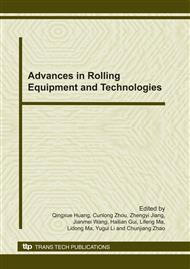p.313
p.317
p.321
p.326
p.332
p.340
p.347
p.353
p.361
Non-Uniform Deformation Characteristic of in 690 Superalloy Tube in Glass Lubricated Hot Extrusion
Abstract:
A two-dimensional axi-symmetric finite element model for the tube hot extrusion process was developed based on Deform-2D software by consideration of the billet transfer, glass lubrication and the constitutive characteristics of IN 690 superalloy. An enhanced technique for adaptive mesh refinement (AR) is used to solve the large deformation problem. This model was then used to study the effect of boundary conditions and process parameters in tube hot extrusion. The Non-uniform deformation index as the representative parameter, which denotes the non-uniform deformation during the steady state of tube hot extrusion, is presented accordance to the feature of metal flow at deformation zone. The bigger of Non-uniform deformation index, the worse of non-uniform strain distribution. When the non-uniform deformation index getting smaller, the equivalent strain distribution along the length and cross section become more uniform and better product quality could be obtained. An increase in the billet and die preheating temperature could reduce the non-uniform deformation index individually. But the billet and die preheating temperature should not be too high. The increase of friction coefficient, the non-uniform deformation index also increased, which indicate appreciable results of metal flow. With the ram speed increase, the non-uniform deformation index decreases, but too fast speed is inadmissibility.
Info:
Periodical:
Pages:
332-339
Citation:
Online since:
October 2010
Authors:
Keywords:
Price:
Сopyright:
© 2011 Trans Tech Publications Ltd. All Rights Reserved
Share:
Citation:


